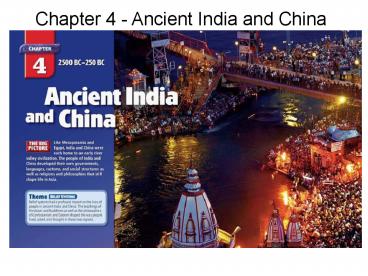Chapter 4 - Ancient India and China - PowerPoint PPT Presentation
1 / 29
Title:
Chapter 4 - Ancient India and China
Description:
Chapter 4 - Ancient India and China Chapter 4 - Ancient India and China Section 1 Early India Section 1 Early India Main Idea Early civilization arose in the ... – PowerPoint PPT presentation
Number of Views:694
Avg rating:3.0/5.0
Title: Chapter 4 - Ancient India and China
1
Chapter 4 - Ancient India and China
2
Chapter 4 - Ancient India and China
3
Section 1 Early India
4
Section 1 Early India
Main Idea Early civilization arose in the Indus
River Valley, flourished, and then mysteriously
died out. Later Indias Vedic civilization
developed a culture based on old and new beliefs.
- Focus
- How did Indias geography affect the development
of civilization there? - What were the defining features of the Indus
Valley Civilization? - What do we know about life in Indias Vedic
period?
5
I. Indias Geography
Indus River - flows across NW edge of Indian
subcontinent
6
A. Three major geographic zones 1. Himalaya
Hindu Kush mountains 2. Deccan Plateau
7
3. Northern or Indo-Gangetic Plain - site of
Indias first civilization
8
B. Monsoons
Monsoon winds brought heavy rains flood deposits
enriched soil
9
B. Monsoons
- Summer monsoons from SW - warm air, heavy rains
from Indian Ocean - Winter monsoons from NE - cool, dry air from Asia
10
B. Monsoons
11
B. Monsoons
Water a critical factor too much/too early
brought destruction too little/too late meant
famine
20cm 7.9in 100cm 39.4in 400cm 13.2ft 800cm
26.3ft 1000cm 32.8ft
12
(No Transcript)
13
II . Indus Valley Civilization
2500 BC - Harappan civilization emerged
14
A. Cities and settlements
1920s ruins from two large cities found -
Harappa and Mohenjo Daro
15
A. Cities and settlements
Well-planned settlements streets in grid
pattern community wells sewage systems
16
The Great Bath was entered using two wide
staircases, one from the north and one from the
south. The floor of the tank is watertight due to
finely fitted bricks laid on edge with gypsum
plaster.
17
A. Cities and settlements
Citadels, granaries, shrines, etc. suggest
centralized government
Excavated ruins of Mohenjo-daro
18
Harappa granary
19
B. Economy
Economy based on agriculture, specialized crafts,
and trade
Ceramic sculpture of a small cart with vases and
tools pulled by oxen, from Mohenjo-daro
20
An artistic conception of the ancient Harappan
city of Lothal
21
C. Society
Standardized tools, weights and measures writing
system not yet deciphered
Seals on products made in Harappa have been found
in Mesopotamia, indicating trade between the two
regions
22
C. Society
Civilization thrived from about 2500 to 2000 BC
declined for unknown reasons
23
III. The Vedic Period
After 2000 BC, Aryans ruled most of India
knowledge of them comes from the Vedas
24
III. The Vedic Period
Regional leaders rajas - protected people in
return for payment
25
III. The Vedic Period
Vedic society was divided into four varnas
26
III. The Vedic Period
27
III. The Vedic Period
Varnas divided into hundreds of castes -
determined employment, marriage etc.
28
III. The Vedic Period
People prayed to many aspects of single spirit
What began as a celebration of natural elements
converted into the worship of cosmic elements,
thus forming the triad of the early Vedic Gods
Agni (Fire), Vayu (Wind) and Surya (the Sun).
29
III. The Vedic Period
As rituals grew more complex, Brahmins gained
influence
The god Vishnu and his many avatars. These
manifestations are essentially the representation
of the deity for some purpose. Each of Vishnus
avatars is a particular person, representative of
a characteristic of the God birth, death,
energy, war, etc.

